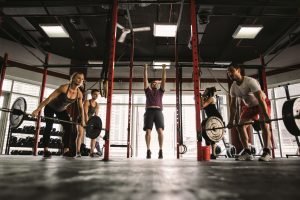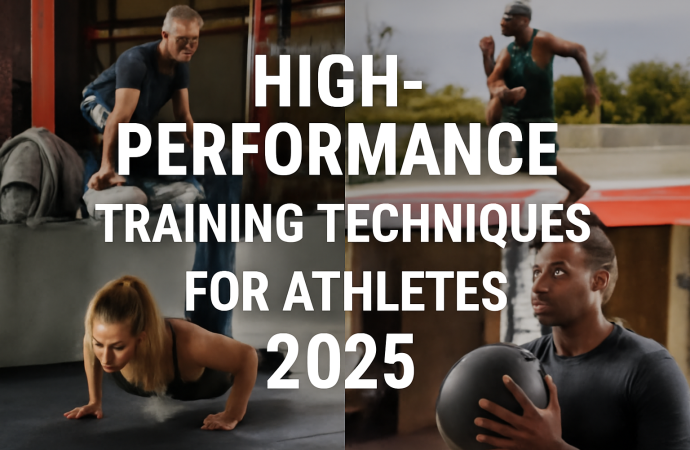Introduction In the world of athletics, staying ahead of the competition is key to success. As we approach 2025, high-performance training techniques are becoming more advanced, integrating technology, science, and psychology to help athletes perform at their best. Whether you’re a professional athlete or someone who simply enjoys staying fit, adopting the right training techniques
Introduction
In the world of athletics, staying ahead of the competition is key to success. As we approach 2025, high-performance training techniques are becoming more advanced, integrating technology, science, and psychology to help athletes perform at their best. Whether you’re a professional athlete or someone who simply enjoys staying fit, adopting the right training techniques is crucial for improving strength, endurance, and overall performance. In this article, we’ll explore the most effective training techniques for athletes in 2025, focusing on methods that optimize results and promote long-term health and fitness.
What is High-Performance Training?
High-performance training refers to a collection of specialized exercise methods and strategies aimed at maximizing an athlete’s ability in their specific sport or activity. It goes beyond basic fitness training and involves optimizing strength, speed, endurance, flexibility, and mental resilience. In 2025, high-performance training for athletes incorporates not only traditional methods but also the latest advancements in sports science and technology.
The goal of high-performance training is not just to build physical strength but also to enhance agility, reaction time, and the mental toughness required to excel under pressure. These methods can be tailored for different athletes, depending on their sport, fitness level, and goals.
High-Performance Training Techniques for 2025
1. Functional Strength Training

Image by: Yandex.com
Functional strength training has become a key component in an athlete’s routine in 2025. This type of training focuses on exercises that mimic movements commonly performed in sports, rather than just isolating muscle groups. By training the body to perform natural, compound movements, athletes can improve their overall functional strength and performance.
Benefits:
- Improves muscle coordination and balance
- Enhances performance in sport-specific movements
- Reduces the risk of injury
- Helps in building strength for real-world activities
Examples of functional strength exercises include kettlebell swings, squat presses, and medicine ball throws. These exercises engage multiple muscle groups and improve overall movement efficiency.
2. High-Intensity Interval Training (HIIT)

Image by: Yandex.com
HIIT has gained immense popularity in recent years, and it continues to be one of the top training methods for athletes in 2025. HIIT involves alternating between short bursts of intense exercise and periods of rest or low-intensity activity. This method has been proven to boost endurance, increase fat burning, and improve cardiovascular fitness.
Benefits:
- Maximizes calorie burn in a short period
- Increases cardiovascular fitness
- Improves both aerobic and anaerobic endurance
- Can be tailored to any sport or activity
Athletes can perform HIIT with bodyweight exercises, cycling, running, or any other form of cardiovascular activity. It’s an efficient way to improve overall stamina and conditioning, especially when time is limited.
3. Recovery and Regeneration Techniques

Image by: Yandex.com
Recovery is just as important as the training itself. In 2025, athletes have access to more advanced recovery techniques that help prevent injury and ensure optimal performance. Proper recovery ensures that the body can rebuild and repair itself after intense training sessions.
Some of the most popular recovery techniques include:
- Cryotherapy: Using cold temperatures to reduce inflammation and speed up muscle recovery.
- Massage Therapy and Foam Rolling: Helps to reduce muscle tightness and improve flexibility.
- Active Recovery: Light exercises such as walking or swimming that increase blood flow without overloading the muscles.
- Sleep Optimization: Ensuring athletes get quality sleep to allow for muscle repair and mental recovery.
Proper rest, hydration, and nutrition also play critical roles in the recovery process.
4. Sports-Specific Training
Sports-specific training focuses on improving the movements and skills that athletes use most often in their sport. This type of training can help athletes perform better in competitions by targeting the key muscle groups and movements they use. In 2025, sports-specific training often incorporates technology like video analysis to perfect technique and form.
Benefits:
- Improves technique and performance in the athlete’s sport
- Builds strength in muscle groups specific to the sport
- Enhances reaction time and agility
- Reduces the risk of overuse injuries
For example, a basketball player may work on explosive jumping, agility drills, and dribbling skills, while a football player may focus on tackling techniques and sprinting.
5. Mindfulness and Mental Training

Image by: Yandex.com
In 2025, mental toughness is recognized as just as important as physical fitness. Mindfulness techniques, such as meditation and visualization, are being incorporated into high-performance training to help athletes improve focus, reduce stress, and maintain a positive mindset during competition.
Benefits:
- Improves focus and concentration
- Enhances emotional resilience under pressure
- Reduces anxiety and mental fatigue
- Increases self-confidence
Mental training can be combined with physical routines to create a balanced approach to performance, ensuring that athletes are mentally prepared to face challenges in their sport.
6. Nutrition and Supplementation
A proper diet is crucial for high-performance training. In 2025, athletes are more aware of the role nutrition plays in fueling their bodies for optimal performance. The right combination of macronutrients (proteins, fats, and carbohydrates), micronutrients (vitamins and minerals), and supplements can make a significant difference in an athlete’s performance.
Benefits of good nutrition include:
- Boosting energy levels
- Enhancing muscle recovery
- Supporting immune function
- Preventing fatigue and injury
Athletes in 2025 often work with sports nutritionists to develop customized meal plans that meet their specific needs. Supplements such as protein powder, BCAAs, and creatine are commonly used to support recovery and muscle growth.
7. Wearable Technology and Data Analysis

Image by: Yandex.com
One of the most exciting innovations in high-performance training is the use of wearable technology. Devices such as smartwatches, fitness trackers, and heart rate monitors allow athletes to track their performance in real time. These devices provide valuable data on things like heart rate, calories burned, sleep patterns, and recovery metrics.
This data is then analyzed to help athletes optimize their training routines and improve their performance. By identifying trends and weaknesses, athletes can make informed adjustments to their workouts.
Benefits:
- Provides real-time performance data
- Tracks progress over time
- Helps optimize training plans based on individual data
- Reduces the risk of overtraining or injury
8. Injury Prevention Strategies

Image by: Yandex.com
Injury prevention is an integral part of high-performance training. With the intense physical demands of athletic performance, injuries can be a major setback. In 2025, injury prevention techniques focus on improving mobility, flexibility, and proper technique.
Athletes are encouraged to incorporate dynamic warm-ups, stretching routines, and strength-building exercises for joint stability. Prehabilitation (prehab) exercises are becoming a popular way to avoid common injuries before they occur.
Benefits:
- Reduces the risk of both acute and chronic injuries
- Helps maintain long-term athletic performance
- Improves flexibility and joint health
- Supports recovery from previous injuries
Conclusion
High-performance training techniques have evolved significantly, and in 2025, athletes have access to a wide range of methods and tools to help them reach their full potential. From functional strength training and HIIT to the use of wearable technology and mental training, athletes today have more resources than ever to improve their performance. By focusing on physical conditioning, recovery, nutrition, and mental resilience, athletes can ensure they are performing at their peak.
Whether you are an aspiring athlete or someone looking to optimize your training routine, incorporating these high-performance techniques into your training plan can make a significant difference in achieving your goals. It’s time to embrace these strategies, improve your performance, and take your athleticism to the next level.
Call-to-Action
Ready to take your training to the next level? Start incorporating these high-performance techniques into your routine and see the difference. For more tips on achieving your best performance, check out our other articles on fitness, nutrition, and sports training.
















